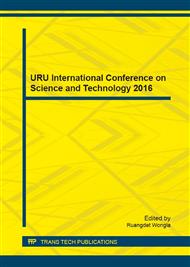[1]
R. Phoophuangpairoj, S. Phongsuphap, and S. Tangwongsan, Gender identification from Thai speech signal using a neural network, Lecture Notes in Computer Science, Vol. 5863, 2009, pp.676-684.
DOI: 10.1007/978-3-642-10677-4_77
Google Scholar
[2]
H. Ting, Y. Yingchun, and W. Zhaohui, Combining MFCC and pitch to enhance the performance of the gender recognition, in Proceedings of International Conference on Signal Processing, 2006, pp.16-20.
DOI: 10.1109/icosp.2006.345541
Google Scholar
[3]
S. M. R. Azghadi, M. R. Bonyadi, and H. Sliahhosseini, Gender classification based on feedforward backpropagation neural network, IFIP International Federation for Information Processing, Vol. 247, 2007, pp.299-304.
DOI: 10.1007/978-0-387-74161-1_32
Google Scholar
[4]
M. H. James and J. C. Michael, The role of F0 and formant frequencies in distinguishing the voices of men and women, attention, Perception and Psychophysics, Vol. 71, 2009, pp.1150-1166.
DOI: 10.3758/app.71.5.1150
Google Scholar
[5]
C. R. Pernet and P. Belin, The role of pitch and timbre in voice gender categorization, Frontiers in Psychology, Vol. 3, Article 23, 2012, pp.1-11.
DOI: 10.3389/fpsyg.2012.00023
Google Scholar
[6]
M. Sigmund, Gender distinction using short segments of speech signal, International Journal of Computer Science and Network Security, Vol. 8, 2008, pp.159-162.
Google Scholar
[7]
D. Ververidis and C. Kotropoulos, Automatic speech classification to five emotional states based on gender information, in Proceedings of the European Signal Processing Conference, Vol. 1, 2004, pp.341-344.
DOI: 10.1109/icassp.2004.1326055
Google Scholar
[8]
A. Deemagarn and A. Kawtrakul, Thai connected digit speech recognition using Hidden Markov Models, in Proceedings of the 9th International Conference on Speech and Computer, 2004, pp.731-735.
Google Scholar
[9]
L. Fuhai, M. Jinwen, and D. Huang, MFCC and SVM based recognition of Chinese vowels, Lecture Notes in Computer Science, Vol. 3802, 2005, pp.812-819.
DOI: 10.1007/11596981_118
Google Scholar
[10]
S. Tangwongsan and R. Phoophuangpairoj, Boosting Thai syllable speech recognition using acoustic models combination, in Proceedings of International Conference on Computer and Electrical Engineering, 2008, pp.568-572.
DOI: 10.1109/iccee.2008.130
Google Scholar
[11]
S. Tangruamsub, P. Punyabukkana, and A. Suchato, Thai speech keyword spotting using heterogeneous acoustic modeling, in Proceedings of IEEE International Conference on Research, Innovation and Vision for the Future, 2007, pp.253-260.
DOI: 10.1109/rivf.2007.369165
Google Scholar
[12]
S. Tangwongsan, P. Po-Aramsri, and R. Phoophuangpairoj, Highly efficient and effective techniques for Thai syllable speech recognition, Lecture Notes in Computer Science, Vol. 3321, 2004, pp.259-270.
DOI: 10.1007/978-3-540-30502-6_19
Google Scholar
[13]
R. Phoophuangpairoj, Using multiple HMM recognizers and the maximum method to improve voice-controlled robots, in Proceedings of International Conference on Intelligent Signal Processing and Communication Systems, 2011, pp.1-6.
DOI: 10.1109/ispacs.2011.6146111
Google Scholar
[14]
G. Guo and S. Z. Li, Content-based audio classification and retrieval by support vector machines, IEEE Transactions on Neural Networks, Vol. 14, 2003, pp.209-215.
DOI: 10.1109/tnn.2002.806626
Google Scholar
[15]
D. Mitrovic, M. Zeppelzauer, and C. Breiteneder, Discrimination and retrieval of animal sounds, in Proceedings of the 12th International Multi-Media Modelling Conference, 2006, pp.339-343.
DOI: 10.1109/mmmc.2006.1651344
Google Scholar
[16]
C. Y. Yeo, S. A. R. Al-Haddad, and C. K. Ng, Animal voice recognition for identification (ID) detection system, in Proceedings of the 7th IEEE International Colloquium on Signal Processing and Its Applications, 2011, pp.198-201.
DOI: 10.1109/cspa.2011.5759872
Google Scholar
[17]
Motlíček P.: Feature Extraction in Speech Coding and Recognition, Report, Portland, to research, data, and theory. Belmont, CA: Thomson/Wadsworth, 2003 US, Oregon Graduate Institute of Science and Technology, pp.1-50, (2002).
Google Scholar
[18]
Hagen A., Connors D.A. & Pellm B.L.: The Analysis and Design of Architecture Systems for Speech Recognition on Modern HandheldComputing Devices. Proceedings of the 1st IEEE/ACM/IFIP international conference on hardware/software design and system synthesis, pp.65-70, (2003).
DOI: 10.1145/944658.944661
Google Scholar
[19]
Ishizuka K. & Nakatani T.: A feature extraction method using subband based periodicity and aperiodicity decomposition with noise robust frontend processing for automatic speech recognition. Speech Communication, Vol. 48, Issue 11, pp.1447-1457, (2006).
DOI: 10.1016/j.specom.2006.06.008
Google Scholar


